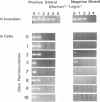Abstract
We developed an in vitro assay for antibodies to hepatitis C virus (HCV) that bind to virions and prevent initiation of the replication cycle in susceptible cells in vitro. These antibodies therefore appear to be capable of neutralizing the virus. Using this assay and a standard inoculum of HCV of known infectivity, we have measured the antibody in serial serum samples obtained from the same chronically infected patient over 14 years following onset of his hepatitis. Such antibody was found in sera collected within 5 years of onset of hepatitis but not in later sera. In double immunoprecipitation experiments with anti-human immunoglobulin, the same sera that contained neutralizing antibody were found to contain antibody that bound to HCV to form antigen-antibody complexes immunoprecipitable with anti-human globulin. Similarly, plasma collected from this patient in 1990, 13 years after onset of hepatitis, and which contained HCV that had diverged genetically from the 1977 strain, did not contain antibody capable of neutralizing either the 1977 or the 1990 strain of HCV. However, plasma collected a year later (1991, 14 years after onset of hepatitis) contained neutralizing antibody to the 1990, but not the 1977, strain of HCV. These results suggest that HCV does induce antivirion antibody, as measured by blocking of initiation of the replication cycle of virus in cells and by the formation of immunoprecipitable antigen-antibody complexes but that these antibodies are isolate specific and change over time. Thus, these antivirion antibodies function as neutralizing antibodies and are probably in vitro correlates of the attempt of the host to contain the emergence of neutralization-resistant variants of HCV over time.
Full text
PDF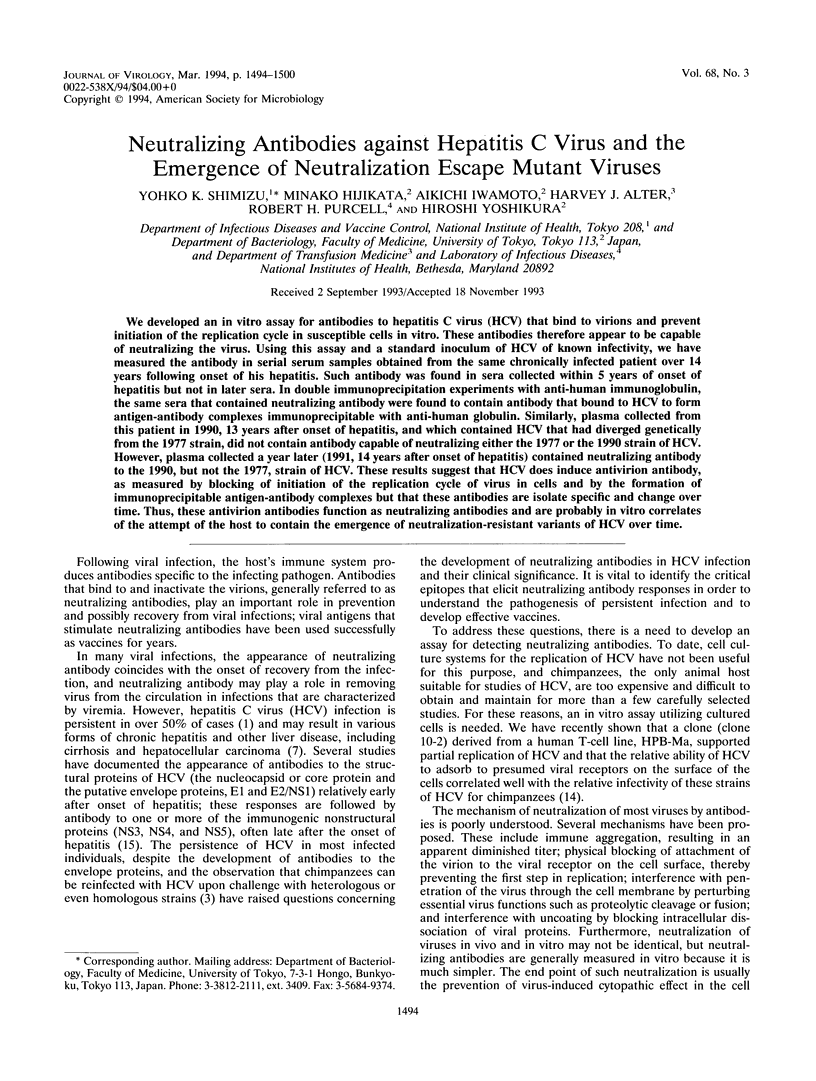
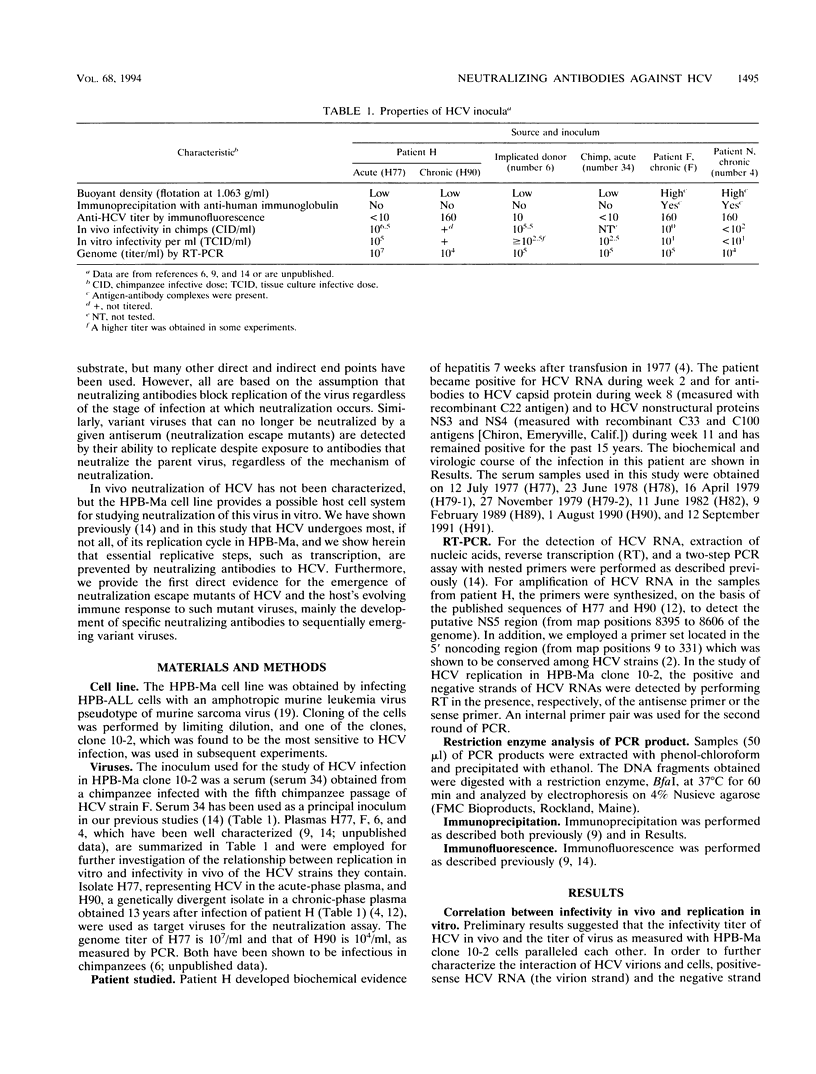
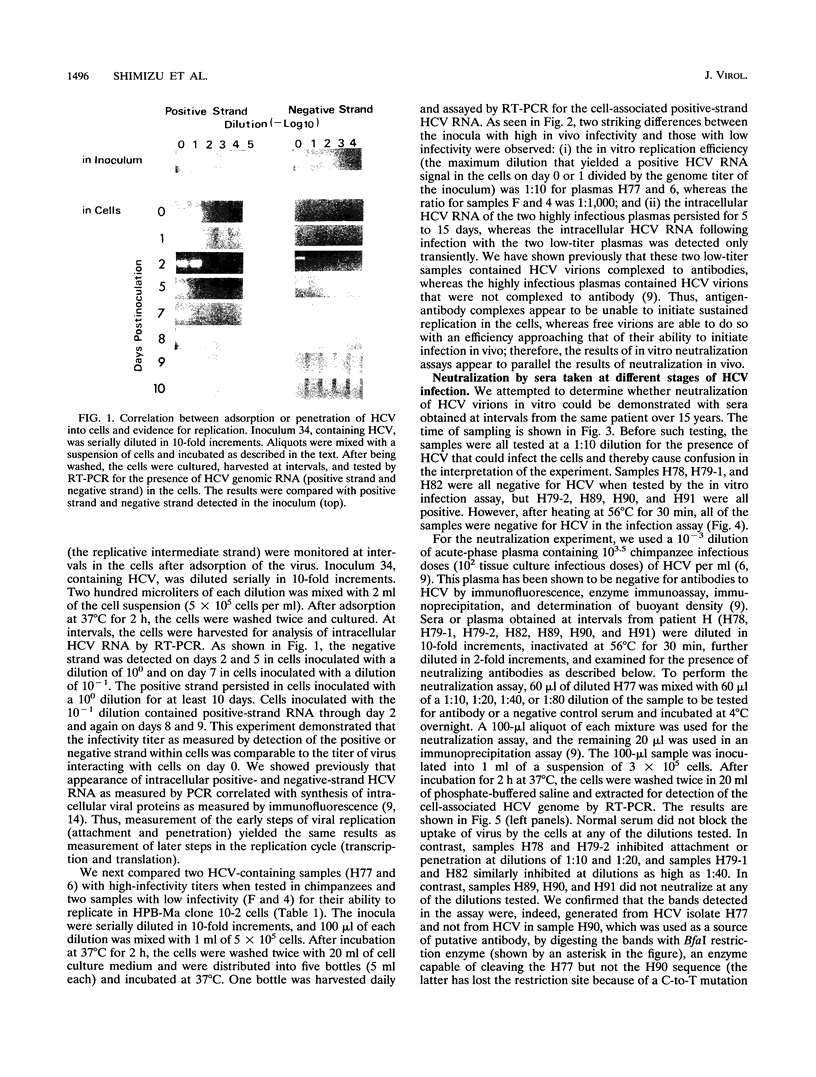

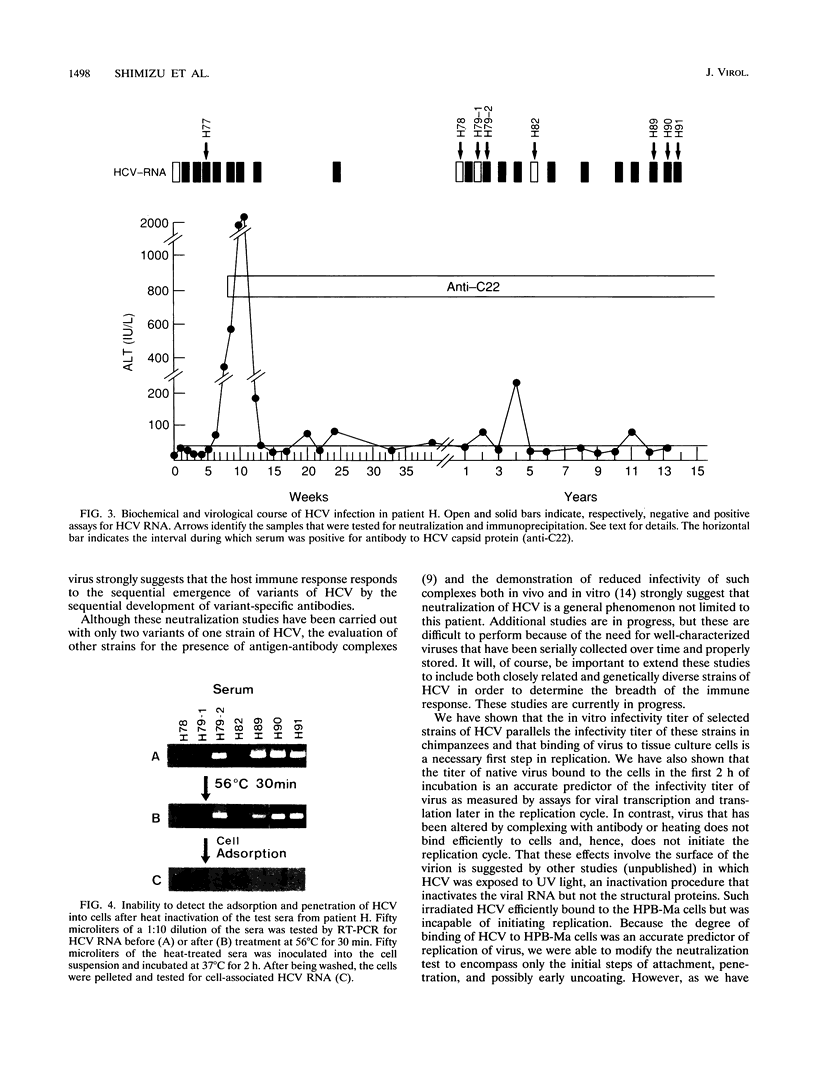


Images in this article
Selected References
These references are in PubMed. This may not be the complete list of references from this article.
- Bukh J., Purcell R. H., Miller R. H. Sequence analysis of the 5' noncoding region of hepatitis C virus. Proc Natl Acad Sci U S A. 1992 Jun 1;89(11):4942–4946. doi: 10.1073/pnas.89.11.4942. [DOI] [PMC free article] [PubMed] [Google Scholar]
- Farci P., Alter H. J., Govindarajan S., Wong D. C., Engle R., Lesniewski R. R., Mushahwar I. K., Desai S. M., Miller R. H., Ogata N. Lack of protective immunity against reinfection with hepatitis C virus. Science. 1992 Oct 2;258(5079):135–140. doi: 10.1126/science.1279801. [DOI] [PubMed] [Google Scholar]
- Farci P., Alter H. J., Wong D., Miller R. H., Shih J. W., Jett B., Purcell R. H. A long-term study of hepatitis C virus replication in non-A, non-B hepatitis. N Engl J Med. 1991 Jul 11;325(2):98–104. doi: 10.1056/NEJM199107113250205. [DOI] [PubMed] [Google Scholar]
- Feinstone S. M., Alter H. J., Dienes H. P., Shimizu Y., Popper H., Blackmore D., Sly D., London W. T., Purcell R. H. Non-A, non-B hepatitis in chimpanzees and marmosets. J Infect Dis. 1981 Dec;144(6):588–598. doi: 10.1093/infdis/144.6.588. [DOI] [PubMed] [Google Scholar]
- Gilliam J. H., 3rd, Geisinger K. R., Richter J. E. Primary hepatocellular carcinoma after chronic non-A, non-B post-transfusion hepatitis. Ann Intern Med. 1984 Dec;101(6):794–795. doi: 10.7326/0003-4819-101-6-794. [DOI] [PubMed] [Google Scholar]
- Hijikata M., Kato N., Ootsuyama Y., Nakagawa M., Ohkoshi S., Shimotohno K. Hypervariable regions in the putative glycoprotein of hepatitis C virus. Biochem Biophys Res Commun. 1991 Feb 28;175(1):220–228. doi: 10.1016/s0006-291x(05)81223-9. [DOI] [PubMed] [Google Scholar]
- Hijikata M., Shimizu Y. K., Kato H., Iwamoto A., Shih J. W., Alter H. J., Purcell R. H., Yoshikura H. Equilibrium centrifugation studies of hepatitis C virus: evidence for circulating immune complexes. J Virol. 1993 Apr;67(4):1953–1958. doi: 10.1128/jvi.67.4.1953-1958.1993. [DOI] [PMC free article] [PubMed] [Google Scholar]
- Kato N., Ootsuyama Y., Ohkoshi S., Nakazawa T., Sekiya H., Hijikata M., Shimotohno K. Characterization of hypervariable regions in the putative envelope protein of hepatitis C virus. Biochem Biophys Res Commun. 1992 Nov 30;189(1):119–127. doi: 10.1016/0006-291x(92)91533-v. [DOI] [PubMed] [Google Scholar]
- Kato N., Sekiya H., Ootsuyama Y., Nakazawa T., Hijikata M., Ohkoshi S., Shimotohno K. Humoral immune response to hypervariable region 1 of the putative envelope glycoprotein (gp70) of hepatitis C virus. J Virol. 1993 Jul;67(7):3923–3930. doi: 10.1128/jvi.67.7.3923-3930.1993. [DOI] [PMC free article] [PubMed] [Google Scholar]
- Ogata N., Alter H. J., Miller R. H., Purcell R. H. Nucleotide sequence and mutation rate of the H strain of hepatitis C virus. Proc Natl Acad Sci U S A. 1991 Apr 15;88(8):3392–3396. doi: 10.1073/pnas.88.8.3392. [DOI] [PMC free article] [PubMed] [Google Scholar]
- Shimizu Y. K., Iwamoto A., Hijikata M., Purcell R. H., Yoshikura H. Evidence for in vitro replication of hepatitis C virus genome in a human T-cell line. Proc Natl Acad Sci U S A. 1992 Jun 15;89(12):5477–5481. doi: 10.1073/pnas.89.12.5477. [DOI] [PMC free article] [PubMed] [Google Scholar]
- Shimizu Y. K., Purcell R. H., Yoshikura H. Correlation between the infectivity of hepatitis C virus in vivo and its infectivity in vitro. Proc Natl Acad Sci U S A. 1993 Jul 1;90(13):6037–6041. doi: 10.1073/pnas.90.13.6037. [DOI] [PMC free article] [PubMed] [Google Scholar]
- Tanaka E., Kiyosawa K., Nakatsuji Y., Inoue Y., Miyamura T., Chiba J., Furuta S. Clinical significance of antibodies to nonstructural and core proteins of hepatitis C virus in posttransfusion hepatitis patients during long-term follow-up. J Med Virol. 1993 Apr;39(4):318–324. doi: 10.1002/jmv.1890390411. [DOI] [PubMed] [Google Scholar]
- Taniguchi S., Okamoto H., Sakamoto M., Kojima M., Tsuda F., Tanaka T., Munekata E., Muchmore E. E., Peterson D. A., Mishiro S. A structurally flexible and antigenically variable N-terminal domain of the hepatitis C virus E2/NS1 protein: implication for an escape from antibody. Virology. 1993 Jul;195(1):297–301. doi: 10.1006/viro.1993.1378. [DOI] [PubMed] [Google Scholar]
- Weiner A. J., Brauer M. J., Rosenblatt J., Richman K. H., Tung J., Crawford K., Bonino F., Saracco G., Choo Q. L., Houghton M. Variable and hypervariable domains are found in the regions of HCV corresponding to the flavivirus envelope and NS1 proteins and the pestivirus envelope glycoproteins. Virology. 1991 Feb;180(2):842–848. doi: 10.1016/0042-6822(91)90104-j. [DOI] [PubMed] [Google Scholar]
- Weiner A. J., Geysen H. M., Christopherson C., Hall J. E., Mason T. J., Saracco G., Bonino F., Crawford K., Marion C. D., Crawford K. A. Evidence for immune selection of hepatitis C virus (HCV) putative envelope glycoprotein variants: potential role in chronic HCV infections. Proc Natl Acad Sci U S A. 1992 Apr 15;89(8):3468–3472. doi: 10.1073/pnas.89.8.3468. [DOI] [PMC free article] [PubMed] [Google Scholar]
- Yoshikura H. Thermostability of human immunodeficiency virus (HIV-1) in a liquid matrix is far higher than that of an ecotropic murine leukemia virus. Jpn J Cancer Res. 1989 Jan;80(1):1–5. doi: 10.1111/j.1349-7006.1989.tb02235.x. [DOI] [PMC free article] [PubMed] [Google Scholar]



